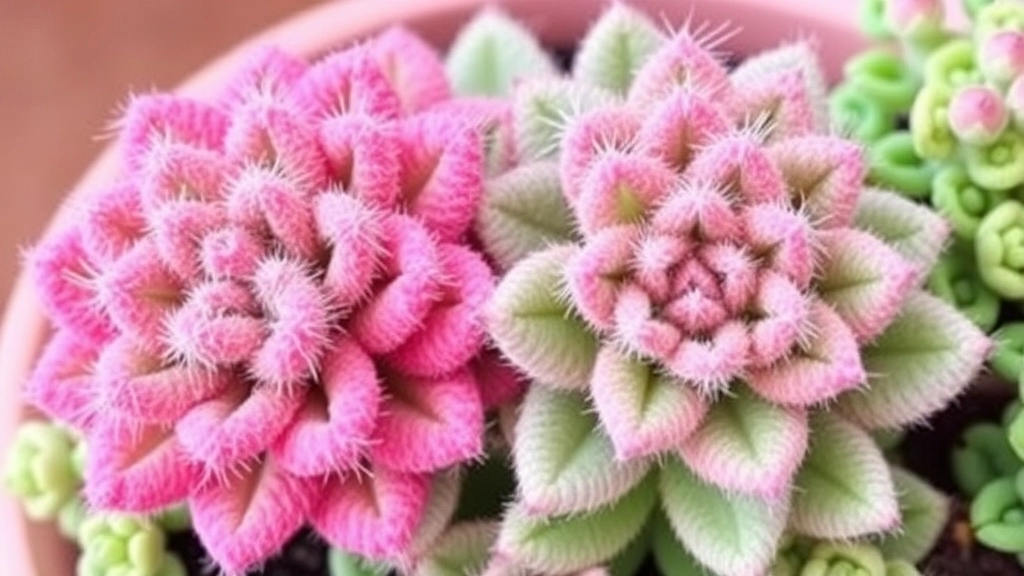Fuzzy Kalanchoe Types
If you’re a gardening enthusiast or a plant collector, you’re probably familiar with the charm of fuzzy Kalanchoe types. These unique succulents, with their soft, velvety leaves, add a touch of whimsy to any plant collection. In this article, we’ll explore some common fuzzy Kalanchoe varieties, their growth habits, and how to identify them.
Understanding Fuzzy Kalanchoe
Understanding the different fuzzy Kalanchoe types is essential for proper care and cultivation. We’ll dive into their specific care needs, propagation methods, and tips for maintaining them both indoors and outdoors. Whether you’re a novice or an experienced gardener, this guide will help you keep your fuzzy Kalanchoe thriving.
Common Fuzzy Kalanchoe Varieties
When it comes to Fuzzy Kalanchoe, many plant enthusiasts often wonder which varieties are the most popular and how they differ.
Fuzzy Kalanchoe, known for its distinctive fuzzy leaves, comes in several varieties, each with its unique charm. Here are some of the most common ones:
- Kalanchoe tomentosa: Often referred to as the ‘Panda Plant’, this variety features soft, velvety leaves with striking brown edges. It’s a favourite for its adorable appearance and resilience. For more details on how to care for this plant, check out our Kalanchoe tomentosa watering best practices.
- Kalanchoe beharensis: Known as the ‘Elephant Bush’, this variety boasts larger, more elongated leaves and a bushy growth habit. It’s perfect for adding height to your indoor garden. Learn how to maintain this plant by visiting our complete care guide for Kalanchoe beharensis.
- Kalanchoe luciae: Commonly called ‘Paddle Plant’, this one stands out with its large, flat leaves that can take on a stunning red hue when exposed to bright light.
- Kalanchoe marnieriana: This variety, or ‘Chandelier Plant’, features unique, tiered leaves that create a striking visual effect, making it a conversation starter.
Each of these varieties offers something unique, whether it’s in leaf shape, colour, or growth habit. Understanding these differences can help you choose the right Fuzzy Kalanchoe for your collection.
Growth Habits of Fuzzy Kalanchoe
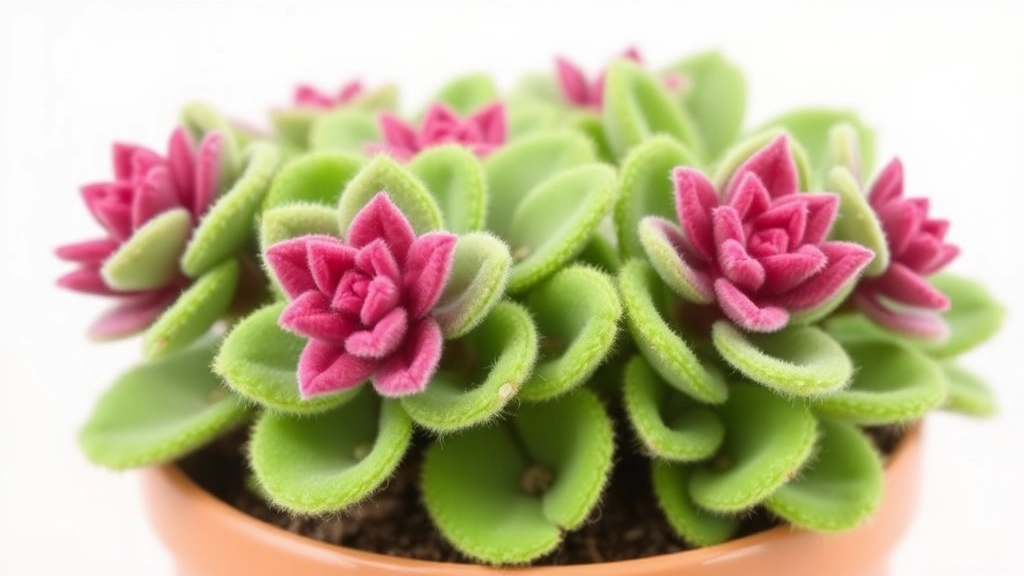
Ever wondered how to keep your Fuzzy Kalanchoe thriving? You’re not alone! These charming plants have some unique growth habits that can make or break your gardening experience.
Fuzzy Kalanchoes, with their soft, velvety leaves, are not just pretty faces. They have distinct growth patterns that can help you tailor your care. Here’s what you need to know:
- Growth Rate: Fuzzy Kalanchoes are relatively slow growers. They won’t take over your space overnight, which is great if you’re looking for a manageable plant.
- Size: Typically, they reach about 30-60 cm in height. Perfect for windowsills or small garden spots!
- Leaf Structure: Their thick, fuzzy leaves not only look adorable but also help retain moisture. This means they can tolerate some neglect when it comes to watering.
- Flowering: These beauties can bloom, usually in the spring. Their small, tubular flowers can be a delightful surprise, adding a splash of colour to your plant collection.
- Light Needs: They thrive in bright, indirect sunlight. Too much direct sun can scorch those lovely leaves, so keep them in a well-lit spot but not in harsh sunlight.
- Temperature Preferences: Fuzzy Kalanchoes prefer temperatures between 15-25°C. They’re not fans of frost, so if you live in a cooler climate, make sure to bring them indoors during winter.
Understanding these growth habits can really help you create the perfect environment for your Fuzzy Kalanchoe.
Identifying Different Fuzzy Kalanchoe Species
When it comes to fuzzy Kalanchoe, many plant enthusiasts often find themselves puzzled by the various species available. How can you tell them apart? What features should you look for?
Key Fuzzy Kalanchoe Species
Here are some of the most common fuzzy Kalanchoe species you might encounter:
- Kalanchoe tomentosa
- Known as the âPanda Plant,â this species features soft, fuzzy leaves with a silvery-green hue and brown edges.
- It’s great for adding a touch of texture to your collection. For more detailed care instructions, check out this ultimate care guide.
- Kalanchoe luciae
- Often referred to as the âFlapjack Plant,â it has large, paddle-shaped leaves that can take on a reddish tint when exposed to sunlight.
- This species stands out for its striking appearance.
- Kalanchoe beharensis
- Known as the âElephant Bush,â it has thick, felted leaves that give it a unique, rugged look.
- It can grow quite tall, making it a focal point in any setting. Learn more about its care in this care and propagation guide.
Identifying Features
To distinguish these species, pay attention to the following characteristics:
- Leaf Shape
- Observe the shape and size of the leaves. Are they round, paddle-like, or elongated?
- Leaf Texture
- Feel the leaves. Are they fuzzy, smooth, or waxy?
- Color Variations
- Note any color changes, especially when the plant is exposed to sunlight.
- Growth Habit
- Observe how the plant grows. Is it upright, sprawling, or bushy?
By focusing on these traits, you can easily identify the fuzzy Kalanchoe species in your collection or at your local nursery.
Care Tips for Fuzzy Kalanchoe
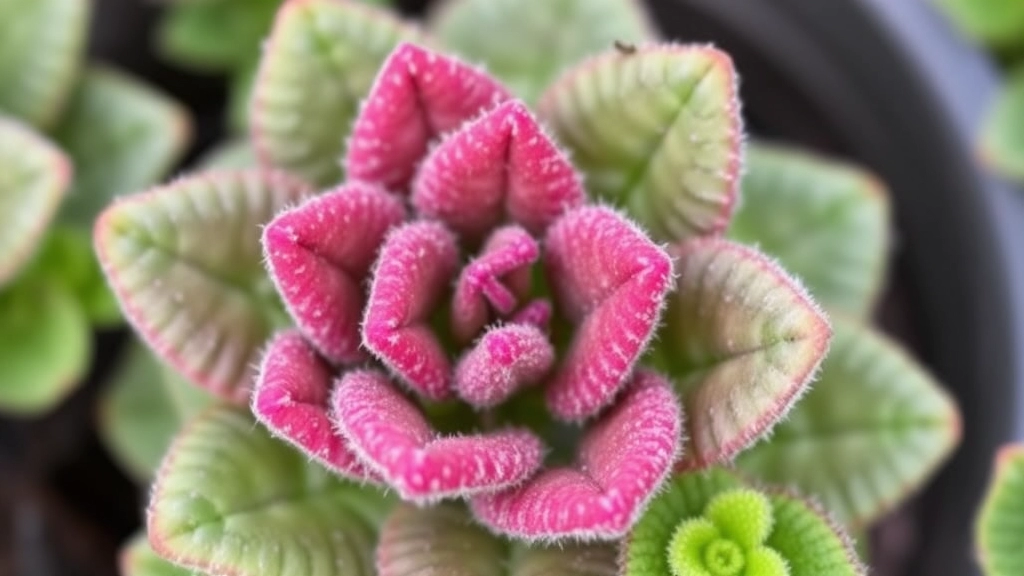
As we delve into caring for Fuzzy Kalanchoe, it’s important to remember that proper care can significantly enhance the health and beauty of these charming plants. Many enthusiasts often wonder about the best practices to ensure their Fuzzy Kalanchoe thrives.
Light Requirements
- Bright, Indirect Sunlight: Fuzzy Kalanchoe prefers bright but indirect sunlight. Too much direct sun can scorch the leaves.
- Rotate Regularly: To ensure even growth, rotate your plant every few weeks.
Watering
- Soil Moisture Check: Allow the top inch of soil to dry out before watering again. Overwatering can lead to root rot.
- Water Sparingly: During winter, reduce watering frequency as the plant enters dormancy.
Temperature and Humidity
- Ideal Temperature: Keep your Fuzzy Kalanchoe in a range of 15°C to 25°C. They thrive in warmer conditions but can tolerate cooler temperatures.
- Humidity Levels: These plants prefer low to moderate humidity. Avoid overly humid environments.
Fertilization
- Use a Balanced Fertilizer: During the growing season (spring and summer), apply a balanced, diluted liquid fertilizer every 4-6 weeks.
- Stop in Winter: Cease fertilization in the winter months to allow the plant to rest.
Pruning and Maintenance
- Regular Pruning: Trim off any dead or damaged leaves to encourage new growth.
- Dusting Leaves: Occasionally wipe the leaves with a damp cloth to remove dust and improve photosynthesis.
Propagation Methods for Fuzzy Kalanchoe
Are you wondering how to multiply your Fuzzy Kalanchoe collection?
Propagation is not only rewarding but also quite simple. Fuzzy Kalanchoes are resilient plants, making them perfect candidates for various propagation methods. Here’s how you can get started:
Indoor vs. Outdoor Care for Fuzzy Kalanchoe
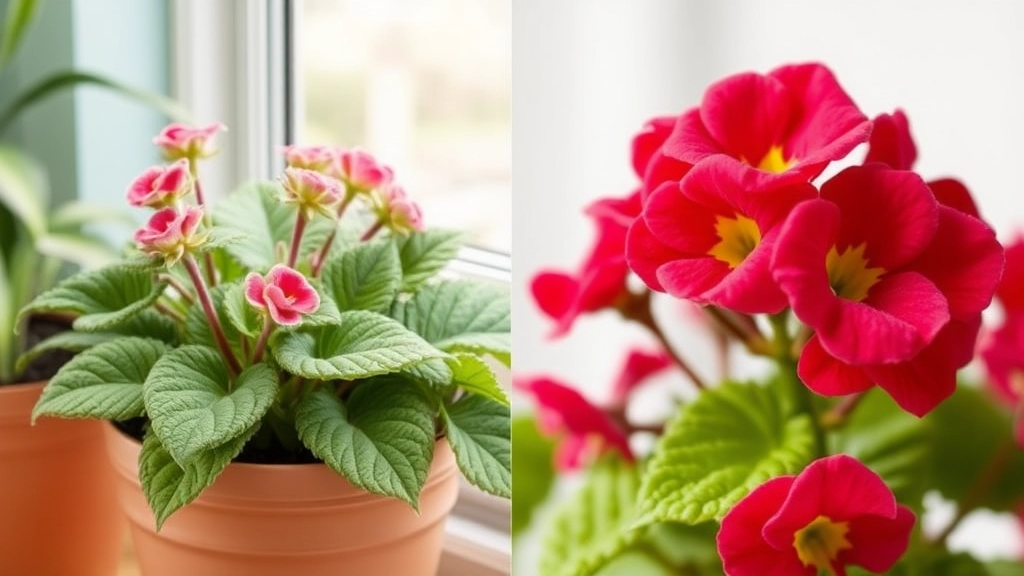
So, you’re thinking about where to keep your Fuzzy Kalanchoe, huh?
It’s a common dilemma for plant lovers: indoors or outdoors?
Both options have their perks, but let’s break it down.
Indoor Care for Fuzzy Kalanchoe
Keeping your Fuzzy Kalanchoe indoors can be a great choice, especially if you live in a cooler climate. Here’s what you need to know:
- Light Requirements: Fuzzy Kalanchoes thrive in bright, indirect sunlight. A south-facing window is ideal.
- Temperature: They prefer temperatures between 15-25°C. Keep them away from drafts and heating vents.
- Watering: Water less frequently during winter. Overwatering is a common mistake. Let the soil dry out completely between waterings.
- Humidity: These plants are pretty forgiving but do best in low to moderate humidity. No need for a humidifier unless your home is super dry.
Outdoor Care for Fuzzy Kalanchoe
If you’re lucky enough to have a garden, planting your Fuzzy Kalanchoe outside can be rewarding. Here’s how to make it work:
- Sunlight: They love full sun! Aim for at least six hours of direct sunlight daily.
- Soil: Well-draining soil is a must. A cactus mix works wonders. Avoid heavy, water-retaining soils.
- Temperature: They can handle warmer weather but don’t let them sit in temperatures below 10°C.
- Watering: Just like indoors, let the soil dry out between waterings. Outdoor plants may need more frequent watering in hot weather.
Common Pests and Diseases of Fuzzy Kalanchoe
As we delve deeper into the care of Fuzzy Kalanchoe, it’s crucial to address a common concern: pests and diseases.
What Pests Affect Fuzzy Kalanchoe?
Fuzzy Kalanchoe can be susceptible to a few pests that may hinder its growth. Here are the most common culprits:
- Mealybugs: These small, white, cotton-like insects often cluster in the leaf axils. They suck sap from the plant, leading to yellowing leaves.
- Spider Mites: Tiny and often invisible to the naked eye, spider mites create fine webs and can cause leaves to become speckled or discolored.
- Aphids: These green or black insects can be found on new growth and can stunt the plant’s growth by feeding on its sap.
- Scale Insects: These pests appear as small, raised bumps on stems and leaves. They can weaken the plant significantly.
Common Diseases to Watch For
In addition to pests, Fuzzy Kalanchoe can also fall prey to certain diseases:
- Root Rot: Overwatering can lead to root rot, which is characterized by mushy roots and a foul smell.
- Powdery Mildew: This fungal disease appears as a white powdery substance on leaves and can hinder photosynthesis.
Preventive Measures
To keep your Fuzzy Kalanchoe healthy, consider these preventive measures:
- Regular Inspections: Check your plants weekly for signs of pests or disease. Early detection is key.
- Proper Watering: Ensure that your plant is not sitting in water. Allow the soil to dry out between waterings.
- Good Air Circulation: Place your Kalanchoe in a well-ventilated area to reduce humidity and prevent fungal issues.
- Neem Oil: This natural pesticide can help control pest populations. Spray it on affected areas as needed.
For more detailed information on caring for your Fuzzy Kalanchoe, check out our Panda Plant Kalanchoe Tomentosa Care Guide and our Succulent Kalanchoe Tomentosa Care Tips and Growing Guide.
Companion Planting with Fuzzy Kalanchoe
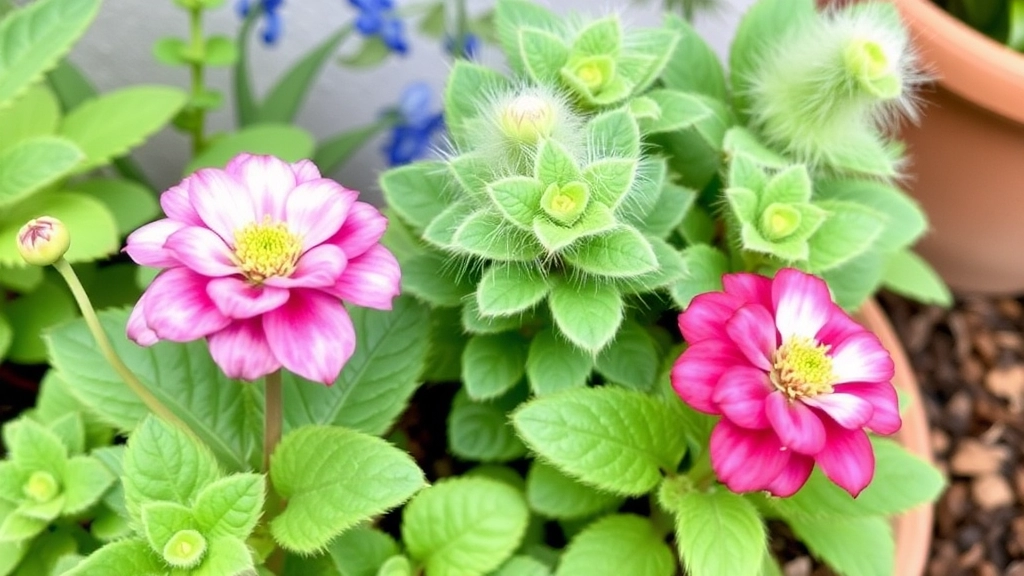
Are you wondering what plants pair well with your fuzzy Kalanchoe? You’re not alone! Choosing the right companions can enhance your garden’s beauty and health.
Why Companion Planting Matters
Companion planting isn’t just about aesthetics; it’s about creating a thriving ecosystem. Some plants can repel pests, while others can provide shade or improve soil quality.
Best Companion Plants for Fuzzy Kalanchoe
Here are some top picks that work wonders alongside your fuzzy Kalanchoe:
- Succulents: They share similar water and light needs. Plus, their diverse shapes and colours create a stunning display.
- Herbs: Basil, rosemary, and thyme thrive in similar conditions. They can also deter pests that might bother your Kalanchoe.
- Cacti: Like succulents, cacti require minimal water and can handle bright light, making them ideal companions.
- Aloe Vera: This plant not only looks good but can also provide health benefits. It’s a low-maintenance buddy!
Tips for Successful Companion Planting
- Spacing: Ensure there’s enough space between plants to avoid overcrowding. This helps with airflow and reduces disease risk.
- Soil Compatibility: Check that your companions thrive in similar soil types. Kalanchoe loves well-draining soil.
- Light Requirements: Group plants with similar light needs. Fuzzy Kalanchoe enjoys bright, indirect sunlight.
Companion planting can be a fun way to experiment and find what works best for your fuzzy Kalanchoe.
Buying Tips for Fuzzy Kalanchoe
When considering adding a Fuzzy Kalanchoe to your collection, you might be wondering where to start.
Here are some practical tips to ensure you choose a healthy and vibrant plant:
FAQs About Fuzzy Kalanchoe Types
What are the growth habits of Fuzzy Kalanchoe?
Fuzzy Kalanchoe plants have distinct growth habits that include a slow growth rate, reaching a height of 30-60 cm, and having thick, velvety leaves that help retain moisture. They bloom in spring and thrive in bright, indirect sunlight, preferring temperatures between 15-25°C.
How much light does a Fuzzy Kalanchoe need?
Fuzzy Kalanchoe prefers bright, indirect sunlight. Too much direct sun can scorch the leaves, so it’s best to place them in a well-lit spot without harsh sunlight.
How often should I water my Fuzzy Kalanchoe?
Allow the top inch of soil to dry out before watering again. Overwatering can lead to root rot. During winter, reduce the frequency of watering as the plant enters dormancy.
What is the ideal temperature for Fuzzy Kalanchoe?
Fuzzy Kalanchoe thrives in temperatures between 15°C to 25°C. They prefer warmer conditions but can tolerate cooler temperatures. Avoid exposing them to frost.
Do Fuzzy Kalanchoe plants need fertilization?
Yes, during the growing season (spring and summer), apply a balanced, diluted liquid fertilizer every 4-6 weeks. Cease fertilization in winter to allow the plant to rest.
How do I care for Fuzzy Kalanchoe indoors?
Indoors, place your Fuzzy Kalanchoe in a spot with bright, indirect sunlight, such as a south-facing window. Maintain temperatures between 15-25°C and water less frequently during winter. These plants prefer low to moderate humidity.
Can Fuzzy Kalanchoe be grown outdoors?
Yes, they can be grown outdoors in well-draining soil. They love full sun and require at least six hours of direct sunlight daily. Ensure temperatures do not drop below 10°C and let the soil dry out between waterings.
What are good companion plants for Fuzzy Kalanchoe?
Good companion plants include succulents, herbs like basil, rosemary, and thyme, cacti, and Aloe Vera. These plants share similar water and light needs, making them ideal companions.
What are the benefits of companion planting with Fuzzy Kalanchoe?
Companion planting can enhance your garden’s beauty and health. Some plants repel pests, provide shade, or improve soil quality, creating a thriving ecosystem.
How should I prune and maintain my Fuzzy Kalanchoe?
Regularly prune dead or damaged leaves to encourage new growth. Occasionally wipe the leaves with a damp cloth to remove dust and improve photosynthesis.
References
-
Gardening Know How – Fuzzy Kalanchoe Care Tips
-
The Spruce – How to Grow and Care for Kalanchoe
-
The Old Farmer’s Almanac – Kalanchoe Plant Care
